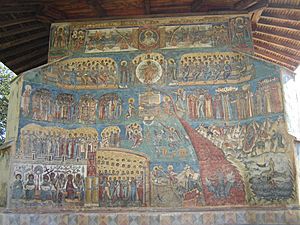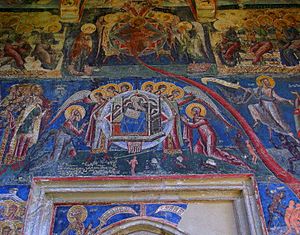The Last Judgment (Toma din Suceava) facts for kids
The Last Judgment is a famous wall painting, called a fresco, found at the Moldovita Monastery in Romania. It was painted by an artist named Toma din Suceava. In Romanian, this artwork is known as "Judecata de Apoi."
This amazing fresco covers the entire west wall of the monastery. It shows the day of judgment, a time when, according to belief, everyone will be judged. The painting includes a fiery river and people rising from the sea. You can also see 105 paintings of angels near the roof.
The Moldovita Monastery is also home to other well-known frescoes. These include the Siege of Constantinople and the Tree of Jesse, which shows the family tree of Jesus.
Contents
Building the Moldovita Monastery
The Moldovita Monastery is a very important place. It is recognized as a UNESCO site, meaning it's protected for its special cultural value. The monastery was started in 1532 by Prince Petru Rares. He was the son of a famous ruler named Stephen the Great.
The new monastery was built where an older stone church once stood. That old church was built by Alexandru cel Bun (who ruled from 1400 to 1432). Sadly, the old church fell apart in the early 1500s because of heavy rain and landslides.
Prince Petru Rares's Vision
Prince Petru Rares ruled a region called Moldavia during two periods: from 1527 to 1538 and again from 1541 to 1546. He had new and exciting ideas for the churches in Bukovina. Rares hired talented artists to decorate the church walls. They covered the walls with detailed paintings of saints, prophets, and scenes from the life of Jesus.
The best-preserved monasteries from this time are in places like Sucevita, Moldovita, Voronet, Humor, Suceava, Pătrăuţi, and Probota. In 1993, seven of these monasteries were added to the UNESCO World Heritage List. The Moldovita Monastery was dedicated to the Annunciation (which means "Good News" in Romanian) on March 25. It is one of five monasteries in northern Moldavia that have frescoes painted on their outside walls.
Moldavian Architecture
The monastery's design is in the style of Moldavian Gothic architecture. This style mixes elements from both Gothic and Byzantine art. It is a Romanian Orthodox monastery, which is a type of Christian church.
The frescoes at Moldovita were finished by Toma of Suceava in 1537. His painting style was influenced by the Italian Renaissance. This means his characters look more human and lifelike.
The Last Judgment in Art History
The idea of death and judgment is often shown in religious art. However, the frescoes in the monasteries of northern Moldavia are truly special. These wall paintings are much more detailed and complex than similar art found in other parts of the old Byzantine Empire. The art from Moldavia even inspired artists in places like Mount Athos.
The oldest known image of the Last Judgment dates back to the seventh century CE. It can be found in a book called Christian Topography by Cosmas Indicopleustes. This old manuscript is kept in the Vatican library. The first scary pictures of the Judgment in fresco form appeared around 1075. These are in the church of San Angelo in Formis, near Naples. The oldest mosaic showing this theme is in Venice, in the church of Torcello. It was likely created in the twelfth century.
Gallery










